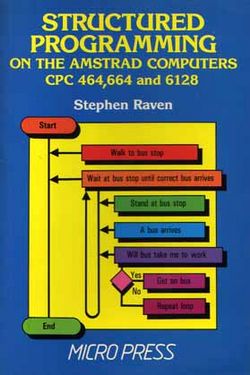Difference between revisions of "Structured Programming on the Amstrad Computers CPC464,664 and 6128"
From CPCWiki - THE Amstrad CPC encyclopedia!
Cpcmaniaco (Talk | contribs) (→Contents) |
Cpcmaniaco (Talk | contribs) (→Information) |
||
| (2 intermediate revisions by the same user not shown) | |||
| Line 1: | Line 1: | ||
[[Image:419px_Structured Programming on the Amstrad Computers.jpg|right|thumb|250px|Frontpage]] | [[Image:419px_Structured Programming on the Amstrad Computers.jpg|right|thumb|250px|Frontpage]] | ||
| − | |||
| − | |||
== Information == | == Information == | ||
{|{{Prettytable|width: 700px; font-size: 2em;}} | {|{{Prettytable|width: 700px; font-size: 2em;}} | ||
| − | |Title:|| Structured Programming on the Amstrad Computers CPC464,664 and 6128 | + | |Title:|| '''Structured Programming on the Amstrad Computers CPC464,664 and 6128''' |
|- | |- | ||
|Authors:|| Stephen Raven | |Authors:|| Stephen Raven | ||
|- | |- | ||
| − | | | + | |Publisher:|| [[Micro Press]] |
|- | |- | ||
|Year:|| 1985 | |Year:|| 1985 | ||
| Line 63: | Line 61: | ||
</pre> | </pre> | ||
| − | [[Category:Books]] | + | [[Category:Books]] [[Category:Book cover]] |
Latest revision as of 06:04, 16 December 2010
Information
| Title: | Structured Programming on the Amstrad Computers CPC464,664 and 6128 |
| Authors: | Stephen Raven |
| Publisher: | Micro Press |
| Year: | 1985 |
| Pages: | 152 |
| ISBN: | 0-7447-0034-5 |
Contents
Section A : Introduction to the Amstrad CPC 464, 664 and 6128. 01 - The machine: its concept and breeding. 02 - Commanding the CPC 664/464 by programming it with instructions. Section B : Familiarity breeds confidence. 03 - BASIC tools of the trade. 04 - Debugging programs. Section C : The principles of BASIC. 05 - Variable names and labels. 06 - Reacting to your CPC 664/464 - INPUT statements. Section D : From little blocks to structured programs. 07 - Structured planning on CPC 664/464 applications. 08 - Diagrams make the mind clearer. 09 - Implementing the plan: 1. 10 - Implementing the plan: 2. Section E : Handling text - the key to information storage. 11 - Strings, string variables and the $ symbol. 12 - Manipulating strings to your advantage. 13 - READ and DATA statements. 14 - Extending variables - dimensional arrays. 15 - Viewing the file, form fil, screen format and data entry. 16 - Processing numerical variables - automatic record updating. 17 - Ideas for applications. 18 - General principles and some reminders. Appendix. Index.
